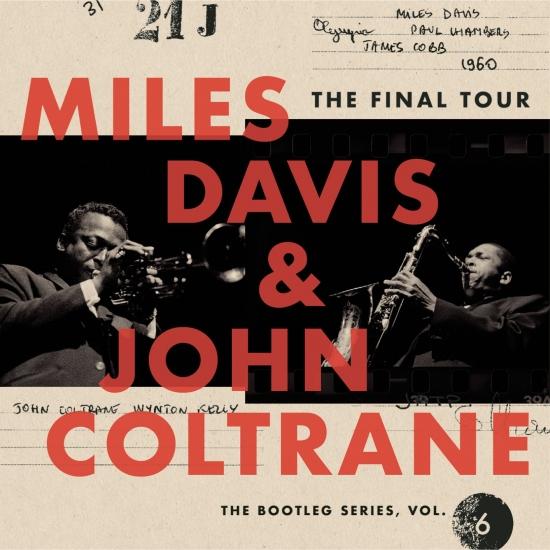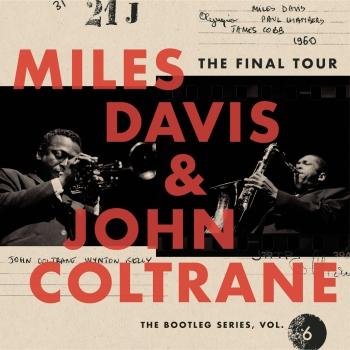
The Final Tour: The Bootleg Series, Vol. 6 (Remastered) Miles Davis & John Coltrane
Album info
Album-Release:
1960
HRA-Release:
23.03.2018
Album including Album cover
I`m sorry!
Dear HIGHRESAUDIO Visitor,
due to territorial constraints and also different releases dates in each country you currently can`t purchase this album. We are updating our release dates twice a week. So, please feel free to check from time-to-time, if the album is available for your country.
We suggest, that you bookmark the album and use our Short List function.
Thank you for your understanding and patience.
Yours sincerely, HIGHRESAUDIO
- 1All of You (Live from Olympia Theatre, Paris)17:05
- 2So What (Live from Olympia Theatre, Paris)13:25
- 3On Green Dolphin Street (Live from Olympia Theatre, Paris)14:40
- 4Walkin' (Live from Olympia Theatre, Paris)15:52
- 5Bye Bye Blackbird (Live from Olympia Theatre, Paris)14:01
- 6Round Midnight (Live from Olympia Theatre, Paris)05:37
- 7Oleo (Live from Olympia Theatre, Paris)04:22
- 8The Theme (Live from Olympia Theatre, Paris)00:50
- 9Introduction (Live from Tivoli Konsertsal, Copenhagen)01:00
- 10So What (Live from Tivoli Konsertsal, Copenhagen)14:36
- 11On Green Dolphin Street (Live from Tivoli Konsertsal, Copenhagen)14:35
- 12All Blues (Live from Tivoli Konsertsal, Copenhagen)15:31
- 13The Theme (incomplete) (Live from Tivoli Konsertsal, Copenhagen)00:31
- 14Introduction by Norman Granz (Live from Konserthuset, Stockholm)01:11
- 15So What (Live from Konserthuset, Stockholm)10:35
- 16Fran Dance (Live from Konserthuset, Stockholm)07:25
- 17Walkin' (Live from Konserthuset, Stockholm)16:21
- 18The Theme (Live from Konserthuset, Stockholm)00:53
- 19So What (Second Concert) (Live from Konserthuset, Stockholm)15:20
- 20On Green Dolphin Street (Live from Konserthuset, Stockholm)13:40
- 21All Blues (Live from Konserthuset, Stockholm)16:10
- 22The Theme (Second Concert) (Live from Konserthuset, Stockholm)00:59
- 23John Coltrane Interview (Live from Konserthuset, Stockholm)06:13
Info for The Final Tour: The Bootleg Series, Vol. 6 (Remastered)
The latest entry in the award-winning Miles Davis Bootleg Series focuses on the final chapter in the landmark collaboration between Davis and saxophonist John Coltrane: their last live performances together, in Europe in the spring of 1960.
Miles and Coltrane first collaborated in 1955, when Davis recruited the tenor saxophonist alongside pianist Red Garland, bassist Paul Chambers and drummer Philly Joe Jones. This "first great quintet" made their Columbia Records debut in 1957. Those early recordings showcased the stunning contrasts between Miles' spacious, melodic lines and Trane's cascading high-energy solos, famously described by the critic Ira Gilter in 1958 as "sheets of sound."
While the quintet disbanded shortly after the release of 'Round About Midnight, Coltrane was back in Miles' ensemble in early 1958. A year late, the Miles Davis Sextet (Davis, Coltrane, Chambers, saxophonist Julian "Cannonball" Adderley, pianists Bill Evans or Wynton Kelly, and drummer Jimmy Cobb) recorded the historic Kind Of Blue, the best-selling jazz album of all time. And for this final tour the rhythm section of Kelly, Chambers and Cobb backed Miles and Trane.
These historic performances marked Miles and Trane's last outing together and showcased both musicians' incredible influence on the changing sound of jazz. The beautiful music they made together is presented here officially for the very first time.
The 4x album set The Final Tour: The Bootleg Series Vol. 6 includes concerts recorded in Paris, Copenhagen and Stockholm.
Miles Davis, trumpet
John Coltrane, tenor saxphone
Wynton Kelly, piano
Paul Chambers, bass
Jimmy Cobb, drums
Digitally remastered
 Trumpeter Miles Davis grew up in East St. Louis, Illinois, just across the river from St. Louis, Missouri. His parents were affluent, and had the means to support his musical studies as a boy. He began playing the cornet at age nine, and received his first trumpet at around twelve or thirteen. He studied classical technique, and focused mainly on using a rich, clear tone, something that helped define his sound in later years.
Trumpeter Miles Davis grew up in East St. Louis, Illinois, just across the river from St. Louis, Missouri. His parents were affluent, and had the means to support his musical studies as a boy. He began playing the cornet at age nine, and received his first trumpet at around twelve or thirteen. He studied classical technique, and focused mainly on using a rich, clear tone, something that helped define his sound in later years.
As a teenager, he played in various bands in St. Louis, which was rich with jazz, as big bands often stopped there on tours throughout the Midwest and southern states. The most important experience he had was when he was asked to play in the Billy Eckstine band for a week as a substitute. The group included Charlie Parker, Dizzy Gillespie, and Sara Vaughan. After playing with these stars, Davis knew he had to move to New York to be at the heart of the jazz scene.
In Pursuit of Parker:
In 1944 Davis moved to New York City where he had earned a scholarship to study trumpet at the Juilliard School of Music. Upon arriving however, he sought after Charlie Parker, and meanwhile spent all of his time in jazz clubs listening to bebop. He was transfixed on the music, and grew utterly bored with his classical studies. After less than a year at Juilliard, he dropped out and tried his hand at performing jazz.
Although not particularly stunning, his playing was good enough to finally attract Charlie Parker, and Davis joined his quintet in 1945. He was often criticized for sounding inexperienced, and was compared unfavorably to Dizzy Gillespie and Fats Navarro, who were the leading trumpeters at the time. Both boasted stellar technique and range, neither of which Davis possessed. In spite of this, he made a lasting impression on those who heard him, and his career was soon set aloft.
Cool Jazz and a Rise to Fame:
Encouraged by composer and arranger Gil Evans, Davis formed a group in 1949 that consisted of nine musicians, including Lee Konitz and Gerry Mulligan. The group was larger than most bebop ensembles, and featured more detailed arrangements. The music was characterized by a more subdued mood than earlier styles, and came to be known as cool jazz. In 1949 Davis released the album Birth of the Cool (Captiol Records).
Change of artistic direction became central to Davis’ long and increasingly influential career. After dabbling in hard bop as a leader on four Prestige recordings featuring John Coltrane, he signed with Columbia records and made albums that featured Gil Evans’ arrangements for 19-piece orchestra. These were Miles Ahead, Porgy and Bess, Sketches of Spain, and Quiet Nights. He rose in popularity with these recordings, in part due to his signature sound, which he often enhanced by using a Harmon mute.
Kind of Blue and Beyond:
In 1959 Davis made his pivotal recording, Kind of Blue. It was a departure from all of his previous projects, abandoning complicated melodies for tunes that were sometimes only composed of two chords. This style became known as modal jazz, and it allows the soloist expressive freedom since he does not have to negotiate complex harmonies. Kind of Blue also featured John Coltrane, Cannonball Adderley, and Bill Evans. The album is one of the most influential in jazz, and is Columbia Records’ best-selling jazz record of all time.
In the mid 1960s Davis changed directions again, forming a group with Herbie Hancock, Wayne Shorter, Tony Williams, and Ron Carter. This group was known for the excellence of each individual member, and also for its unique performance approach. Each night the tunes would sound different, as the musicians would sometimes only loosely adhere to the song structures, and often transition from one right into the next. Each player was given the chance to develop his solos extensively. Like all of Davis’ previous groups, this quintet was highly influential.
Late Career:
Despite health problems, drug addiction, and strained personal relationships, Davis continued to play, changing his approach with each new project. In the late 60s and 70s, he began to experiment with electronic instruments, and grooves that were tinged with rock and funk music. Two famous recordings from this period are In a Silent Way and Bitches Brew. By the time the 1980s rolled around, Davis was not only a jazz legacy, but a pop icon, whose music, persona, and fashion style were legendary.
Davis died in 1991, as perhaps the most influential jazz artist ever. His vast body of work continues to be a source of inspiration for today’s musicians. (Jacob Teichroew, About.com Guide)
This album contains no booklet.











